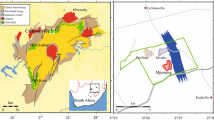Abstract
On the bases of a field geostructural and geomechanical survey, we evaluate the stress field and structural regime responsible for the deformation of the rock-mass in the Machaerus area, the Hashemite Kingdom of Jordan, on the eastern side of the Dead Sea Transform Fault. The resulted data are compared to those from deep mines and base tunnels in order to evaluate the potentiality of using geostructural data to envisage the stress-field for new geoengeneering projects. It resulted the Machareus rock mass was deformed at a depth of about 500–900 m with a deviatoric stresses of the order of σ 1 =15 MPa, σ 2 =10 MPa and σ 3 =−25 MPa, being σ 3 vertical. The stress field orientation is consistent with the left-lateral kinematics of the nearby Dead-Sea transform fault.
Similar content being viewed by others
References
M. Barjous and S. Mikbel, “Tectonic evolution of the Gulf of Aqaba-Dead Sea transform fault system,” Tectonophysics, 180 (1990).
Y. Hatzor and Z. Reches, “Structures and paleostress in the Gilboa region, western margins of the central Dead Sea rift,” Tectonophysics, 180 (1990).
H. Ron, A. Nur, and Y. Eyal, “Multiple strike-slip fault sets: A case study from the Dead Sea Transform,” Tectonics, 9 (1990).
E. D. Laws and M. Wilson, “Tectonics and magmatism associated with Mesozoic passive continental margin development in the Middle East,” Journal of the Geological Society of London, 154 (1997).
R. W. H. Butler, S. Spencer, and H. M. Griffiths, “Transcurrent fault activity on the Dead Sea Transform in Lebanon and its implications for plate tectonics and seismic hazard,” Journal of the Geological Society of London, 153 (1997).
A. Sagy, Z. Reches, and A. Agnon, “Hieratic three-dimensional structure and slip partitioning in the western Dead Sea pull-apart,” Tectonics, 22 (2003).
O. V. Lunina, Y. Mart, and A. S. Gladkov, “Fracturing patterns, stress fields and earthquakes in the Southern Dead Sea rift,” Journal of Geodynamics, 40 (2005).
R. L. Kovach, G. E. Andreasen, M. E. Getting, and K. El-Kaysi, “Geophysical investigation in Jordan,” Tectonophysics, 180 (1990).
P. L. Hancock, A. Al-Kadhi, A. A. Barka, and T. G. Beven, “Aspects of analysing brittle structures,” Annales Tectonicae, 1, No. 1 (1987).
M. Coli and N. Coli, “Geology of the Machaerus archaelogical site in the Hashemite Kingdom of Jordan,” Boll. Soc. Geol. It., [in press] (2006).
C. D. Martin, “Characterizing in situ stress domains at the AELC Underground Research Laboratory,” Can. Geotech. J., 27 (1990).
J. G. Ramsay and M. I. Huber, “The techniques of the modern structural geology,” 2, Folds and Fractures, Academic Press, London (1987).
P. L. Hancock and M. S. Atiya, “Tectonic significance of mesofracture systems associated with the Lebanese segment of the Dead Sea Transform fault,” Journal of Structural Geology, 1 (1989).
P. L. Hancock, “Joint spectra,” in: Geology in the Real World — the Kingsley Dunham Volume, Eds. Nichol I. & Nesbitt R.W., Inst. Min. Metallurgy, London (1986).
A. Teller, “Uniform rock classification system for blasting,” in: III Convegno di Geoingegneria “Scavo in Roccia: Il Futuro e il Futuribile”, Torino (1992).
D. A. Williamson and C. R. Kuhn, “The unified rock classification system,” in: Rock Engineering Systems for Engineering Purposes, ASTM STP 984, Louis Kirkaldie Ed., American Society for Testing Materials, Philadelphia (1988).
R. Hack and M. Huisman, “Estimating the intact rock strength of a rock mass by simple means,” in: Proceedings of the 9th Congress of the International Association of Engineering Geology and Environment, Durban, Republic of South Africa (2002).
R. Christiansson and C. D. Martin, “In-situ stress profiles with depth from site characterization programs for nuclear waste repositories,” in: Proceeding of Rock Mechanics “A Challenge for Society”, Sarkka & Eloranta (Eds.), A.A. Balkema Pub., Lisse, The Netherlands (2001).
A. A. Griffith, “Theory of rupture,” in: Proceedings of 1st International Congress on Applied Mechanics, Delft (1924).
B. Kister, P. Teuscher, and H. J. Ziegler, “Lotschberg-basis tunnel Spannungsmessungen und felsmechanische Untersuchungen im Fensterstollen Mithoz,” in: Proceedings of Eurock2000, Aachen, Verlag, Essen (2000).
Alpetunnel. Rapporto Finale Degli Studi Preliminari per il Tunnel di Base del Frejus, Alpetunnel (2002).
E. Hoek, P. K. Kaiser, and W. F. Bawden, Support of Underground Excavation in Hard Rock, Balkema, Rotterdam (1995).
O. A. Pfiffner and J. G. Ramsay, “Constraints on geological strain-rate: arguments from finite strain states of naturally deformed rocks,” J. Geoph. Res., 87 (1982).
Author information
Authors and Affiliations
Corresponding author
Additional information
__________
Translated from Fiziko-Tekhnicheskie Problemy Razrabotki Poleznykh Iskopaemykh, No. 5, pp. 49–55, September–October, 2009.
Rights and permissions
About this article
Cite this article
Coli, M., Coli, N. Stress-field evaluation by geostructural and geomechanical prospection: The case history of the machaerus rock-mass (Hashemite Kingdom of Jordan). J Min Sci 45, 452–458 (2009). https://doi.org/10.1007/s10913-009-0056-z
Received:
Published:
Issue Date:
DOI: https://doi.org/10.1007/s10913-009-0056-z



